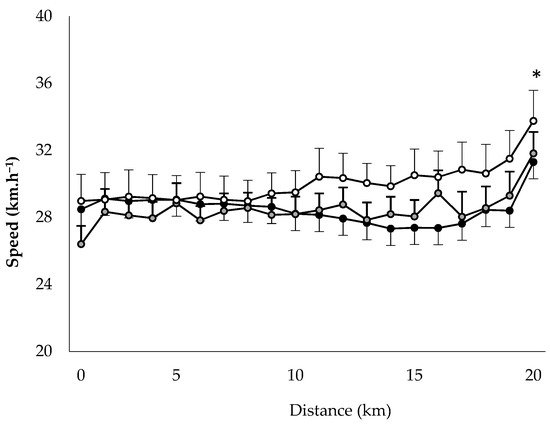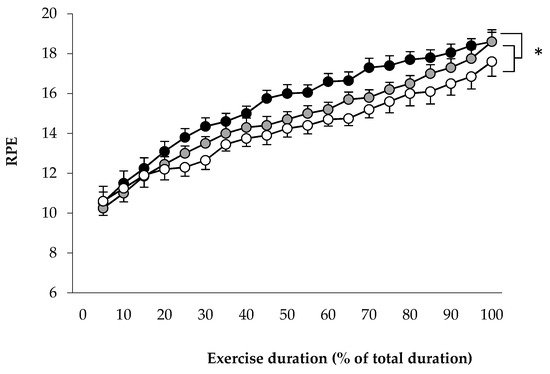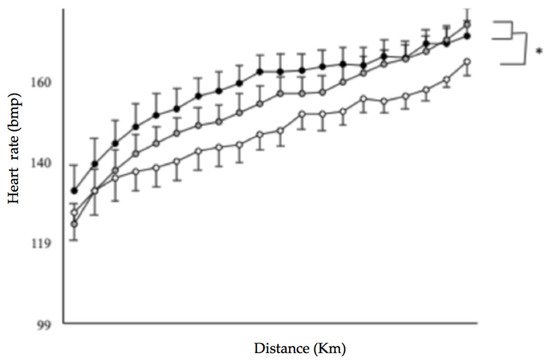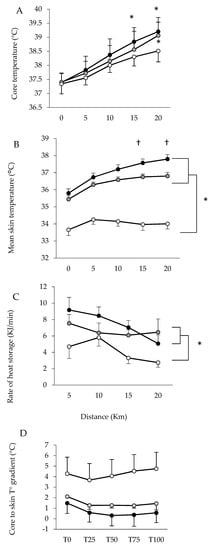It has been demonstrated that the peripheral fatigue developed during exercise in the heat is not a direct cause of decreased aerobic performance, which might instead be due to “central fatigue” [
4]. In hot/humid climate, aerobic performance is also impaired because of the high RH of the air. Interestingly, in this study the participants declared a significantly greater RPE, which is a subjective parameter, in HUMID compared with DRY and NEUTRAL, reflecting the strain of the environment. The force produced in the vastus lateralis muscle during the MVCs was affected by exercise to the same amplitude in the three conditions. Nevertheless, we found that TWq remained the same in NEUTRAL, DRY and HUMID, indicating that the capacity of the skeletal muscle to produce force was not altered. Thus, %iEMG significantly decreased during exercise only in the HUMID condition. The %iEMG was reduced from the 15th km in HUMID compared with DRY and from the 11th km in HUMID compared with NEUTRAL. It has been shown that a hot ambient temperature causes a reduction in iEMG [
8], whereas our study demonstrated that ambient humidity was responsible for the reduction in iEMG. This result is the major novelty of this study. According to the literature, a 2 °C difference impairs perceptual responses (without impact on performance) [
19], whereas in our study, even a 1 °C difference in Tskin was associated with lower iEMG (but not performance). Moreover, the core to skin temperature gradient was enhanced in NEUTRAL compared with DRY and HUMID, indicating that convective heat loss was facilitated in NEUTRAL. In other words, a lower core to skin temperature gradient measured in the heat could be responsible for the diminution of the performance [
7]. The highest speed over any 10% interval was therefore recorded in the last 10% for all three conditions, indicating that the participants had the ability to voluntarily activate skeletal muscles when cycling at maximum speed in the trials. With regard to the proposition that the CNS limits exercise-induced hyperthermia by reducing the power output of exercise, we can hypothesize that decreased motor control (at a cortical and/or spinal level) early in HUMID and DRY (at the 15th km) adjusted the motor unit recruitment. Interestingly, Trec was not different between DRY and NEUTRAL for the first 15 km or between HUMID and NEUTRAL for the first 10 km. However, %iEMG was diminished, even though the participants’ core temperatures did not reach critical values. Additionally, the assumption that a critical core temperature would be reached, leading to exhaustion [
2,
20], was not corroborated by our study, because the participants finished the time trials without a critically high Trec (39.2 ± 0.5 °C in HUMID, 39.1 ± 0.5 °C in DRY and 38.5 ± 0.4 °C in NEUTRAL) and showed no evidence of heat illness at the end of the trials. Furthermore, when participants experience dehydration under heat stress in hot/dry climate, this combination can lead to a reduction in skeletal muscle blood flow [
21]. In hot/humid climate, sweating does not result in heat loss and athletes performing aerobic exercise will become increasingly dehydrated [
22], with impaired endurance performance [
23]. A recommendation to ingest 600 mL before arriving at the laboratory was given to the participants to prevent dehydration. In addition, they were allowed to drink ad libitum which has been demonstrated to assure an optimal rate of fluid absorption in the laboratory and in ecological experiments [
24,
25]. In the present laboratory study, the rate of BML was significantly higher in HUMID than in NEUTRAL). Yet, current studies completed in ecological conditions have suggested that BML is not directly linked to a decreased in aerobic performance [
26]. Similar BMLs in hot/humid environment have been described for a 27-km trail running race, i.e., a decrease of 3.9 ± 1.1% [
10]. Likewise, the authors demonstrated in a half-Ironman triathlon that athletes did not conserve their body mass within the recommended range of 2–3% [
9], but this did not indicate that the participants were hypohydrated [
27], even though urine osmolality was significantly augmented after the race compared with immediately before. Indeed, it has been demonstrated in well-trained unacclimatized male runners that fluid ingestion failed to provide any ergogenic benefit in attenuating thermoregulatory and circulatory stress during exercise not only in warm dry conditions, but also in warm humid environment [
28]. We observed a decreased BML of 2.6 ± 0.5 kg·h
−1 (equivalent to 2.7 ± 0.5 % of BMLs) in HUMID conditions. This result indicates that although sweat evaporation was unproductive, the sudation did not stop or diminish compared to DRY, even in acclimated participants, in accordance with previous observations [
29].
Authors have reported that an increased Trec is correlated with RPE during a dynamic exercise [
4,
30]. Trec is usually considered to have a greater impact than Tskin on the impairment of aerobic performance [
31]. Indeed, a 1 °C-variation in Trec provides from ~70% to 90% of the circulatory response at the skin level and rate of sweating, in the thermoregulatory mechanisms [
32]. Nevertheless, during exercise in the heat, an elevation in the skin temperature will not only trigger the thermoregulatory mechanism, but might also initiate afferent signals from thermo-receptors in the cutaneous tissues, which could be responsible for thermal perception in the control of human thermoregulatory behavior. A correlation was shown between high skin temperature and thermal discomfort, and this could play an important role in the selection of the intensity of a prolonged self-paced exercise [
33]. In our study, we found that mean Tskin was higher in HUMID compared with DRY at 15 and 20 km and throughout the HUMID trial compared with NEUTRAL. A rise in Tskin could thus generate afferent feedback that reduces the CNS recruitment of skeletal muscle. This would explain the decrease in %iEMG in HUMID at 11, 15 and 19 km compared with NEUTRAL, and at 15 and 19 km compared with DRY. It has in fact been suggested that the CNS combines several afferent signals from different systems involving respiration, heart, muscles and thermoreceptors, and that it regulates motor command in order to defend organ integrity during exercise [
17,
34]. We speculate that this concept of a “central governor” could be generalized to heat, given that working muscles generate heat, which is then enhanced by the environmental strain of a hot/humid climate.






